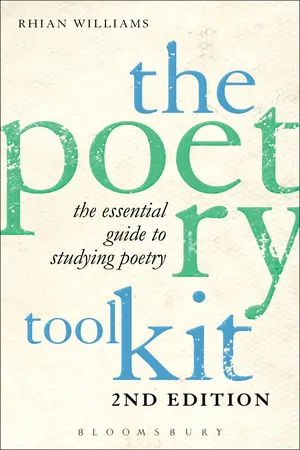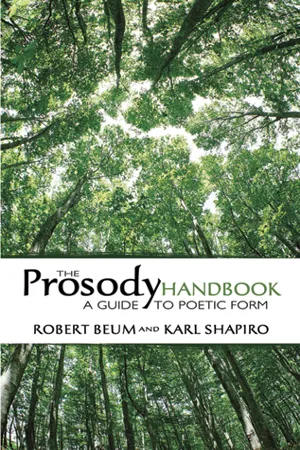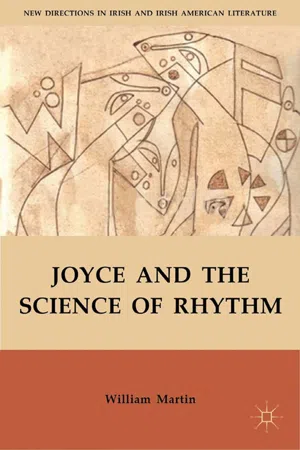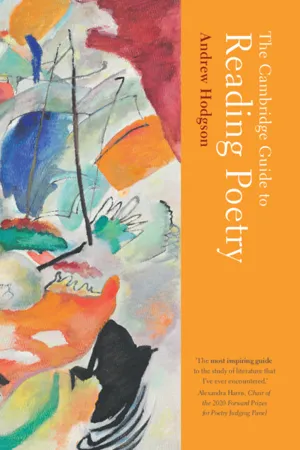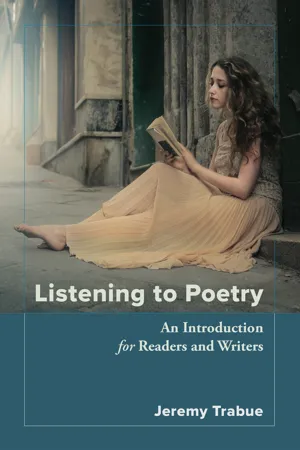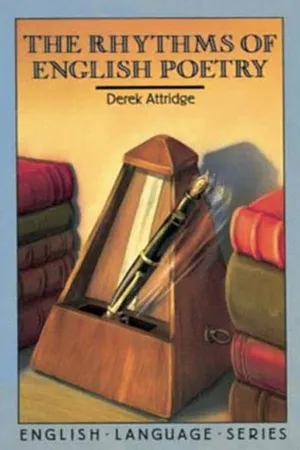Literature
Dactyl
A dactyl is a metrical foot in poetry consisting of one stressed syllable followed by two unstressed syllables. It is often used in classical poetry and can create a rolling, rhythmic effect. In English poetry, dactyls are less common than in classical verse but can still be found in certain forms and styles.
Written by Perlego with AI-assistance
7 Key excerpts on "Dactyl"
- eBook - PDF
- Rhian Williams(Author)
- 2013(Publication Date)
- Bloomsbury Academic(Publisher)
When they are used more playfully or colloquially, as in some of Browning’s poems, the Dactyl falls in more with other triple-syllabled feet, such as anapaests, which, as we’ve seen, at one time were regarded as ‘unpoetic’, disruptive, unruly feet that distracted from the serious mode of contemplation that some readers wished to preserve for poetry. Thus we see that feet have culture to bring to a poem as well as a rhythm; Annie Finch’s study considers this notion in more detail, and her introduction includes a useful summary of the cultural associations ascribed to metrical feet. References Finch, Annie, The Ghost of Meter: Culture and Prosody in American Free Verse (Michigan: University of Michigan Press, 1993). Hopkins, Gerard Manley, Journals and Papers , ed. Humphry House (Oxford: Oxford University Press, 1959), pp. 274–5. —‘Author’s Preface’, in Catherine Phillips ed., Gerard Manley Hopkins: The Major Works (Oxford: Oxford University Press, 2002), pp. 106–9. Meynell, Alice, The Flower of the Mind (London: Grant Richards, 1893). 3.4 Metrical lines Stich A line of poetry. Having seen how lines of verse fall into feet, we come to naming these lines metrically; that is, after their metre. The term ‘stich’ is used fairly infrequently, in fact; a line of poetry tends to be characterized first by the type of feet it includes and secondly by the number of feet. If the number of feet varies in each line of the poem then the metre is named simply after the type. This chilling example by Southey mainly uses iambic feet, but the line lengths vary: Prosody 159 [Old Sa -] [rah loved ] [her help -] [less child ] [Whom help -] [less-ness ] [made dear ;] And life was happ i ness to him Who had no hope nor fear . Robert Southey, ‘The Idiot’ (1798), ll. 5–8. Here the number of feet shifts between four and three per line and so the poem may be described as showing alternating iambic tetrameter (four feet) and trimeter (three feet). - eBook - ePub
The Prosody Handbook
A Guide to Poetic Form
- Robert Beum, Karl Shapiro, Karl Shapiro(Authors)
- 2012(Publication Date)
- Dover Publications(Publisher)
iii ), where the dog is going at a merry clip, the speed of both trisyllabic feet is exploited: Dactylic in the first line, anapestic in the second. The Dactyl is probably even better suited to such comic and exuberant effects than to elegiac ones. Linguistic peculiarity and speed are no embarrassment in a light-hearted context.- (v) Hail to the brightness of Zion’s glad morning; Joy to the lands that in darkness have lain; Hushed be the accents of sorrow and mourning; Zion in triumph begins her mild reign.
The meter of these lines by Thomas Hastings is as banal as the language, which is hymnal cliché. The meter is perfectly regular, and such inflexibility is wooden enough in itself; but to make matters worse, this slick, pat, “commercial” rhythm is completely in conflict with the grandeur and masculine strength of the vision. The experience proposed is one of joy and exaltation, but the speed and abnormality of rhyming Dactylic meter can result only in hollow and pretty sentiment.SPONDAIC AND PYRRHICWhen stresses occur in succession, meaning almost always demands that some be heavier than others. Consequently, there are few or no true spondees in English verse. But notice in the lines above, from Yeats’s “Among School Children,” that the stresses on the syllables of the third and fourth feet of the first line, and of the fourth foot of the second line, are more nearly spondees than iambs. It is not really important, however, to be concerned about the feet. What is important is to notice that the four consecutive stresses (three primary and one secondary, perhaps) of the first line slow the rhythm to match the sense beautifully. The speaker, an old man who has come as a public official to inspect a school, is walking through a long - eBook - PDF
- W. Martin(Author)
- 2012(Publication Date)
- Palgrave Macmillan(Publisher)
419. The Principal Feet occurring in English Verse are: — DISYLLABIC. (Adapted to double move- ment.) TRISYLLABIC. (Triple move- ment.) THE IAMBUS, consisting of an unac- cented followed by an accented syllable; as, to-day. THE TROCHEE (in Greek, running, trip- ping), consisting of an accented followed by an unaccented syllable; as, twinkle. THE SPONDEE (from the Greek spondai, a solemn treaty), consisting of two accented syllable; as, downright. THE Dactyl (from the Greek daktulos, a finger which has one long joint and two short ones), consisting of an accented sylla- ble followed by two unaccented syllables; as, tenderly. THE ANAPEST (struck back ), the Dactyl reversed, consisting of two unaccented syl- lables followed by one that is accented; as, Isabelle. Joyce and the Science of Rhythm 44 metrical correspondences. As Quackenbos lists a number of prosodic manuals in the “Further Reading” section appended to the lesson on “Versification,” it should be a fairly simple matter to reconstruct the sources of his hybrid system. With regard to the classification of the rhythmic feet, it is likely that he drew upon Brewer’s Orthometry (1893), for the latter makes a distinction between “disyllabic” and “trisyllabic” feet, and uses macrons and breves to denote the stressed and unstressed syllables of English verse. Significantly, Brewer cites the definition of rhythm contained in Guest’s History of English Rhythms (1882), which is remarkable for the author’s stress upon the spatial arrangement of the rhythmic structure: “Rhythm in its widest sense may be defined as a law of succession. It is the regulating principle of every whole that is made up of proportionate parts, and is as necessary to the regulation of motion, or to the arrangement of matter, as to the orderly succession of sounds” (2). - eBook - PDF
- Andrew Hodgson(Author)
- 2021(Publication Date)
- Cambridge University Press(Publisher)
In practice, such occurrences are rare: it is seldom that one syllable in a foot doesn’t take slightly more emphasis than another, even if both seem very heavily or lightly stressed. Spondaic and pyrrhic feet never form the basis of any metrical poem in English – they are best reserved for describing interrup- tions to a prevailing metrical pattern and are perhaps most usefully thought of as positions to which iambic or trochaic feet might tend when the difference in emphasis between the syllables in a foot is very slight, and not phenomena which commonly occur in their ideal form. Even in the abstract, we can begin to see how different metrical patterns open up different possibilities of expression. Tap out a sequence of trochees – DUM-der | DUM-der | DUM-der . . . – and a sequence of anapaests – der-der-DUM | der-der-DUM | der-der-DUM .. . – and you will hear the rhythms wreathing themselves around the beats with differing pace and texture. To calculate the length of a line, we count the number of metrical feet – and consequently the number of beats – it contains. The names for describing these lengths are derived from Greek, and are as follows: monometer – one foot dimeter – two feet trimeter – three feet tetrameter – four feet pentameter – five feet hexameter – six feet (sometimes known as an alexandrine) 78 Reading a Poem heptameter – seven feet octometer – eight feet Differing lengths of line, as we have seen, open up different possibilities of movement and expression. Shorter lines tend to give a rapid, staccato feel, leaving little space within the line to expand beyond a single phrase or image and little scope to vary the metrical pattern; four-foot lines tend to create an emphatic regular beat – you find them often in popular song and ballad forms – and they are well suited to witty poems, like the example from Prior above; five-foot lines dampen that beat, and allow more flexibility and variety of modulation. - eBook - PDF
- Christiana Gregoriou(Author)
- 2017(Publication Date)
- Red Globe Press(Publisher)
❚ 1.2 Rhythm and metre ‘Rhythm’ is something we perceive in many things, such as the beating of our hearts, the sound of a machine, or indeed music. It is essentially a pattern of stresses, the perception human beings have of ‘on’ and ‘off’ beats, strong and weak ones, correspondingly referred to as the ‘ictus’ (/) and the ‘remiss’ (X). In the context of the English language, this rhythm is evident in the amount of time that elapses between the stressed syllables of words. Poetry, as a special linguistic form, ‘has more marked, and more complex, rhythmic effects than ordinary language because it has an extra layer of rhythmic structuring which is usually called metre ’ (Short, 1996: 127). Metre is a pattern of rhythm which is perceived to be deliberately regular. Metrical feet in poetry are defined on the basis of this regular pattern, and carry only one strong syllable each. A set of Greek-derived terms have traditionally been used to classify patterns of rhythm into metres that are ‘iambic’ (that is ‘X /’, such as the stress in ‘before’), ‘trochaic’ (that is ‘/ X’, such as in ‘butter’), ‘anapaestic’ (that is ‘X X /’, such as in ‘reconstruct’) and ‘Dactylic’ (that is ‘/ X X’, such as in ‘passenger’). Depending on the number of metrical feet that a poem’s lines have, we use the again Greek-derived terms ‘monometer’ (one-metre line), ‘dimeter’ (two-metre line), ‘trimeter’ (three-metre line), ‘tetrameter’ (four-metre line), ‘pentameter’ (five-metre line) and ‘hexameter’ (six-metre line). Let us look at some examples of the various forms. According to Short (1996: 132), the metrical norm for English poetry, from the fifteenth century onwards, is the iambic pentameter. Michael Drayton’s ‘Since there’s no help, come let us kiss and part’ ([1619]; in Woudhuysen, 1993) follows this decasyllabic (ten-syllable) metre. - Available until 18 Jan |Learn more
Listening to Poetry
An Introduction for Readers and Writers
- Jeremy Trabue(Author)
- 2019(Publication Date)
- Chemeketa Press(Publisher)
This funny little poem was written as a lesson for the poet’s son to teach him to recognize the metrical feet by showing them in action. If you read it out loud, it does give you good examples of how the different rhythms sound. The poet uses classical terminology here, referring to stressed syllables as “long” and unstressed as “short.”from “Metrical Feet” Trochee trips from long to short; From long to long in solemn sort Slow Spondee stalks, strong foot!, yet ill able Ever to come up with Dactyl’s trisyllable.5 Iambics march from short to long.With a leap and a bound the swift Anapests throng. Samuel Taylor Coleridge, 1806Let’s break it down into its constituent syllables and feet with the same highlighting we’ve been using. A vertical line separates each foot:Isn’t that clever? Every line describes the kind of foot it is exclusively made out of.Tro• chee |trips• from |long• to |short;From •long| to •long| in •sol| emn •sortSlow•Spon| dee •stalks, |strong•foot!, | yet •ill| a • bleEv• er • to |come• up • with |Dac• tyl’s • tri |syll• a • ble.I •am| bics •march| from •short| to •long.With • a •leap| and • a •bound| the • swift •An| a • pests •throng.The Line
Each line name is itself two parts. The second half of each is always “meter,” sensibly enough. The first half is the Greek word for a number:Monometer is a line of one foot.Dimeter is a line of two feet.Trimeter is a line of three feet.Tetrameter is a line of four feet.Pentameter is a line of five feet.Hexameter is a line of six feet.Heptameter is a line of seven feet.Octameter is a line of eight feet.People who think too hard about these categories disagree about whether or not a line longer than octameter is possible. At any rate, attempts at longer metrical lines are rare. It doesn’t happen in any traditional meters or forms. The most common lines in English are tetrameter and pentameter. - eBook - ePub
- Derek Attridge(Author)
- 2014(Publication Date)
- Routledge(Publisher)
This is not so, however, even within the literary tradition; while the four-beat line has often been used with this kind of variation (Coleridge’s ‘Christabel’ is perhaps the most self-conscious example), the pentameter has usually been distinguished by a more rigorous control of the number of syllables, its preference for duple rhythms and initial offbeats producing in strict metrical styles a count of ten, or eleven if a feminine ending is used, and only slightly more variety in freer styles. To understand this difference, we need to look a little more closely at the role of the syllable in the rhythms of English verse. While there are external reasons for the emphasis in different periods of literary history on a fixed syllable count, these cannot explain the success of this metrical principle in English; the achievements of Shakespeare, Spenser, Milton, and Wordsworth can hardly rest on a metre which is foreign to the language in which they wrote. It will be recalled that in Chapter 3 we found evidence for regarding the syllable as an elementary rhythmic unit of language, and it is likely, therefore, that apart from acting as the carrier of stress patterns and creating duple or triple rhythms, it can play a metrical role in its own right. The stress rhythm of English is too dominating for this role to be a major one, as it is in French verse, but we have already noted that the tendency towards isochrony in English is circumscribed by the rhythmic effect of the syllables between stresses
Index pages curate the most relevant extracts from our library of academic textbooks. They’ve been created using an in-house natural language model (NLM), each adding context and meaning to key research topics.
